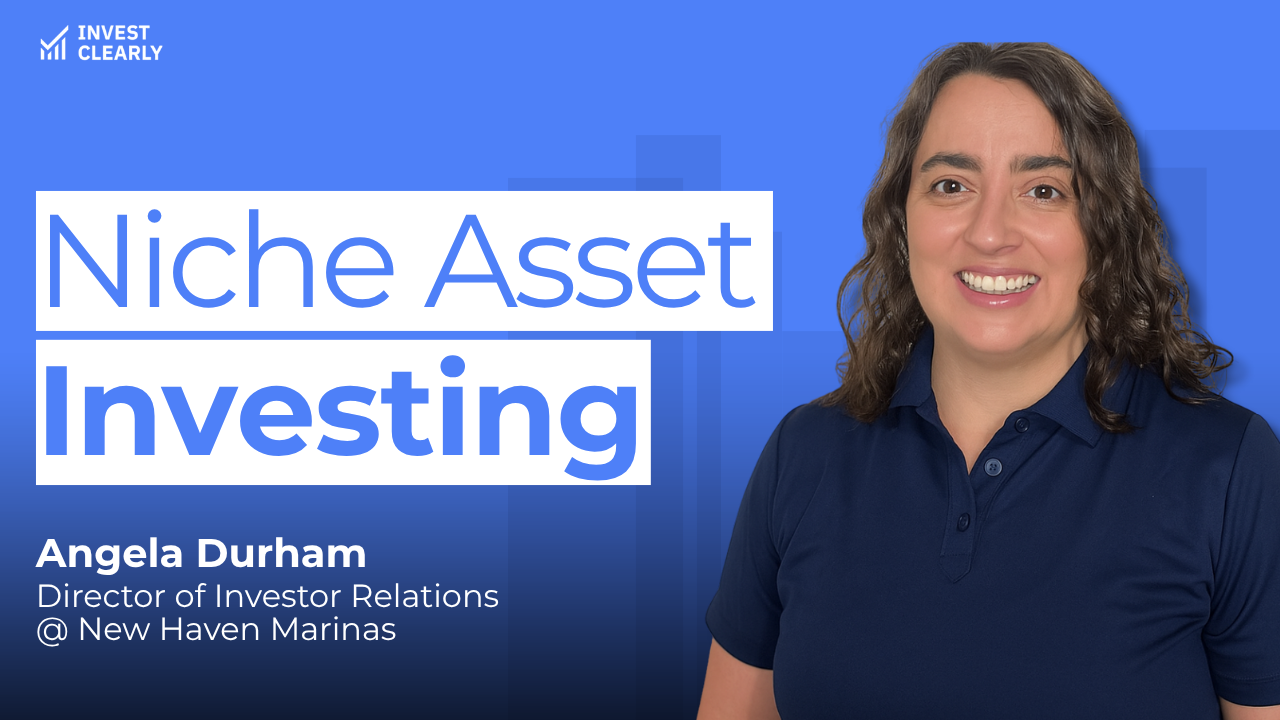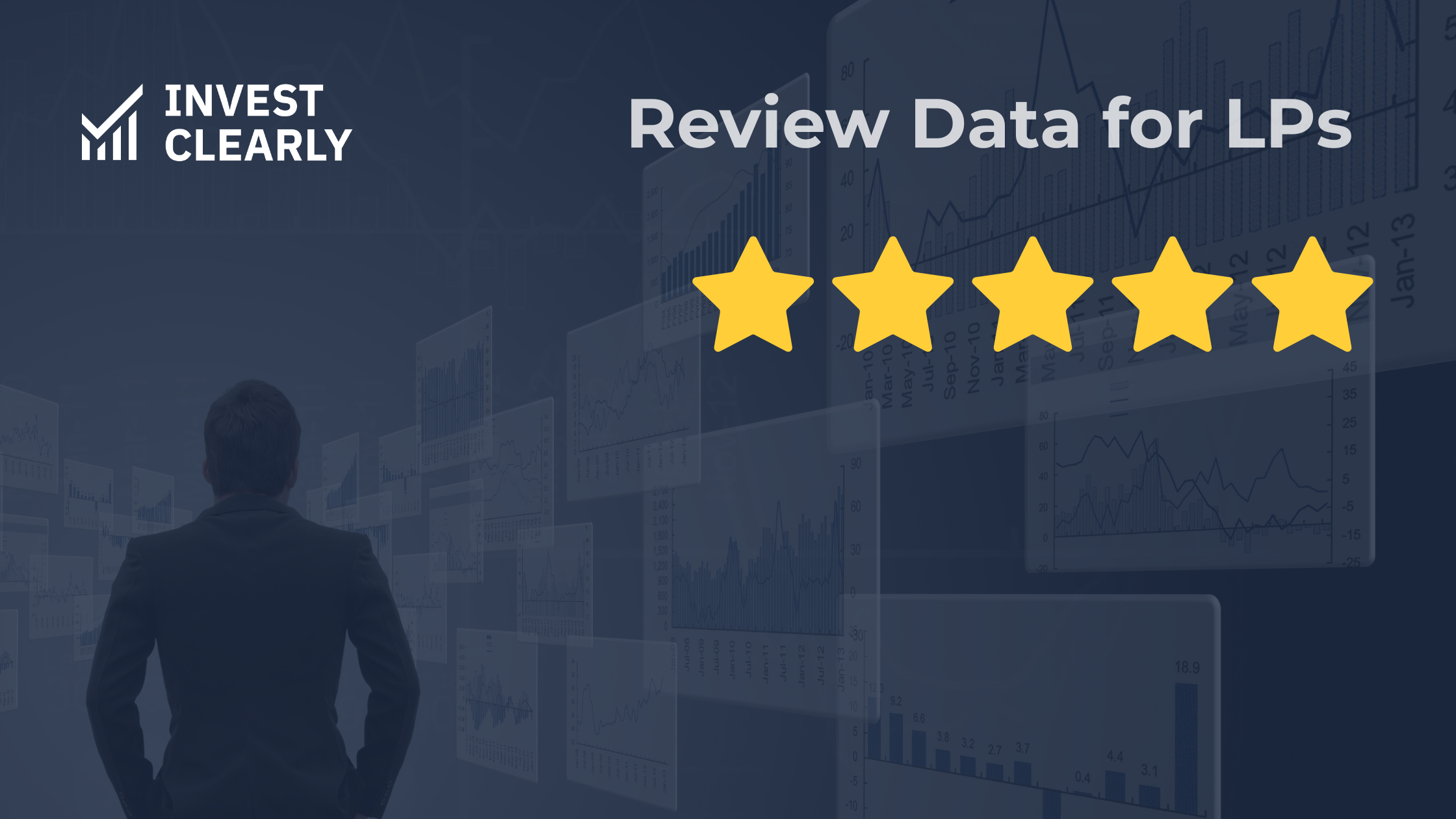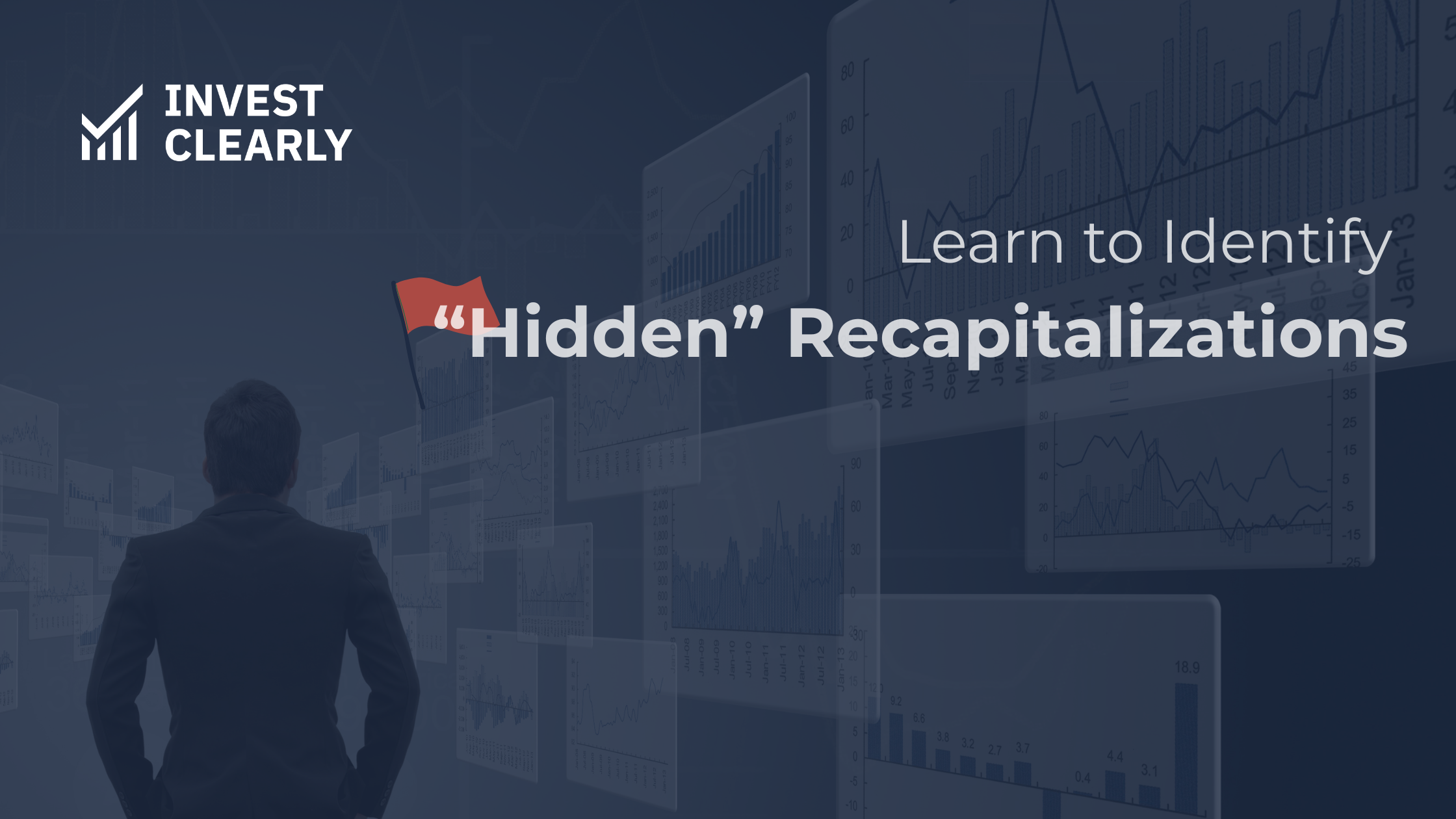
Investor Education in a Niche Asset Class with Angela Durham
Never miss an Invest Clearly Insights article
Subscribe to our newsletter today
In this conversation, Angela Durham discusses the operations and investment strategies of New Haven Marinas, focusing on acquiring and consolidating marina properties.
She highlights the unique aspects of marina investments, including the lifestyle appeal, the importance of investor education, and the specific underwriting risks associated with this niche market.
The discussion also covers the significance of building investor trust through transparency and effective communication, as well as the strategies for scaling operations and managing investor expectations. Angela emphasizes the need for thorough due diligence in passive investing, particularly in the context of marina operations.
Investor Education in a Niche Asset Class with Angela Durham
[00:00:21] Pat: Investors and operators, welcome back to the Invest Elite Podcast. I'm your host and CEO of Invest, Pat Zarella. In today's episode, we sit down with Angela Durham of New Haven Marinas, a sponsor focused on acquiring and operating marina assets across the Sunbelt. Angela shares how her team approaches investor communication in a niche asset class, navigating questions around land leases, water rights, and deferred maintenance. We talk about fund structure, cap rate adjustments, and how LP feedback shaped their reporting and post-acquisition strategy. Let's get into it.
[00:00:47]
[00:01:08] Pat: Angela, thank you so much for joining me. I got to build a relationship before Best Ever Conference. You guys got involved in Invest, clearly. So why don't you take maybe 30 seconds, tell us about New Haven Marinas, what you guys are doing, and then we can hop right into it.
[00:01:22] Angela: Sure, thanks Pat. At New Haven Marinas, we're acquiring and consolidating marina properties, mostly in the Sunbelt region where people can come out and enjoy the water six or seven months out of the year. These are properties that have about six or more revenue streams. So it's not just a place to park a boat, even though we love the long-term rent revenue that comes from that, but really a place where people can enjoy the water and spend money on other ancillary revenue streams. We're acquiring these from mom-and-pop operators and adding value very quickly by raising rents, improving their overall operational efficiencies, and then adding additional wet slips to grow the revenue.
[00:02:02] Pat: Yeah, that's awesome. I have a very unique position in this industry where I get to see different asset classes emerging. I've actually brought up marinas on a couple podcast episodes just as one of those examples because we're seeing a lot of demand for these niche things. So in the theme of Invest—clearly it's all around investor trust—I imagine, and correct me if I'm wrong, that marinas are not what we would call a mainstream asset class yet. So I imagine you're pulling a lot of investors from multifamily, retail, and industrial into marinas. What are the trust-based conversations like with new LPs that are maybe trying to get educated, and then you guys are also trying to sell? What is that balance like for you with these investors?
[00:02:48] Angela: Yeah, a hundred percent of our investors to date definitely have multifamily and some of the others that you mentioned in their portfolio. So they're very familiar with commercial real estate, rent, and value add. Really, we're just focusing a lot on timing and helping them understand the progression path that commercial real estate has gone through. Very similar to multifamily 20-plus years ago when that really started becoming big, self-storage had gone through a consolidation after that, mobile home parks, senior housing, even funeral homes. When we talk about timing, a lack of consolidation in this industry, and really showing how people can come to the water, pay their rents, which they'll pay year-round, but then also spend on additional ancillary revenue streams that really can add to the bottom line that they can participate in. I think another thing that's really interesting is that it's more of a lifestyle investment. A lot of our investors not only invest in real estate already, but they're also boaters and they've been to a marina. They may understand how difficult it is to get a wet slip right now. Those investors really understand the value of these types of properties and just how much money their friends and their family and themselves are spending at these properties, and they want to take part in it. We'll educate on the similarities and then also really the timing. A lot of that has to do with entry and exit cap rates that are available right now. A lot of these mom-and-pop operators haven't raised rents for five, six-plus years, so the ability to raise rents on day one really outweighs and exceeds that of other asset classes right now. And so that gives us an opportunity to show them value pretty quickly and illustrate that to them.
[00:04:43] Pat: Super interesting. Yeah, I live in a marina district. I'm on the shoreline, and so I see that lifestyle. I've spoken to a few of them and it is really interesting. So when you think about the difference in the core real estate and the marina, is there an underwriting risk that people may not think about when coming into this for the first time? Say they're exploring investing in a deal or an asset with New Haven Marinas and they're doing their due diligence. Is there something you advise? Hey, this is much different than your core real estate operations. This is what you should look out for and this is what you should be underwriting from a risk analysis standpoint.
[00:05:24] Angela: Yeah, I would say weather plays a part in that. Weather we can't control. We focus mostly on properties that do not experience hurricanes, so insurance is definitely a big thing when it comes to marinas. I would also say that it's not like a typical property. A lot of the properties in the country, about 70%, are under a land lease, and the other 30% are fee simple where marina owners actually own the land. Now with water rights, there's always regulatory bodies that govern the water rights everywhere. No marina owner actually owns the water itself, and so that introduces some additional layers of complexity, things that we need to take a look at. We'll look back 10-plus years on not only financials but also any sort of environmental history, and all of that, so we can really evaluate that. Now in addition to that, deferred maintenance with a marina—of course you've got your typical things, any of the structures like restaurants and retail ship stores, any repairs that need to be made there, obviously parking lots, improvements that we can make like dog parks or playgrounds for kids. But in addition to that, under the water and in the dock systems. A lot of these will need to be fully encapsulated so that the foam is not actually going out into the water systems. And so that's something that we look at a lot to understand, in the next two to three years, would we need to encapsulate these dock systems where the boats are parked or is that already completed, and then factor in those costs if needed.
[00:07:06] Pat: That's so interesting. And so when LPs are underwriting these, are you guiding them through these unique things to look out for? Or is this learned due diligence? What is that like when someone's coming to you for the first time?
[00:07:22] Angela: Yeah, we definitely share those details per property. Most of the marinas that we've acquired to date are already 95 to 100% fully encapsulated. They may be a B or a B-plus type class property, if you're comparing it to other asset classes. Whenever we do this, we're looking at the insurance premiums in history, five-year loss runs, before we acquire them in our due diligence periods. And then we will plug that into our current master group policies that allow us, this year for an example, to save 12% in annual insurance premiums. And so we can really factor all of that in, and then we would provide an underwriting model to investors on a per-property basis. Our current offering is a fund structure where we should have two or three marinas, and so each of those would look slightly different. They all have the same type of acquisition criteria, but we'll let investors know how many wet slips they have, obviously how many we can add, how many we plan to add in the first year, how much it should cost to do that, and factor in each of the individual cost projections for each marina.
[00:08:32] Pat: Interesting. Very cool. And we talked a little earlier about, I guess, the balance of education and marketing. I talked to somebody recently who does retail but for cannabis tenants, so there was a lot of education on the unique value prop there. When you're talking to new investors, do you find it being a multi-call process where it's not just a, "Hey, here's the deal, underwrite, wire in 30 days," or is it a longer sales cycle, and I guess how do you guys manage that?
[00:09:00] Angela: Yeah, so if we look at our offering last year, about a third of the capital that we raised was from people that had found us online and inquired. Maybe they were a boat owner or they understood the supply and demand issues right now, or saw one of our ads talking about above-average IRR metrics that we have. And I would say on average it was about a two-month timeline from the time that they found us, and we had on average I'd say about three phone calls. A lot of times people want to understand, is this recession-proof or recession-resistant, and we'll talk a lot about that. They may not understand the types of properties that we're acquiring, which include very popular lakes that millions of people visit every year, or properties where a lot of the marina or the boat and RV owners are digging in with both heels. So they may have a houseboat that they live at year-round and they're renting a slip from us. They may have an RV campsite that they've built extravagant decks around and they're not going anywhere. That's actually their way of life. That's their lifestyle. And so the occupancy remains very high. Even when we have people moving out, within a matter of hours, we typically have those slips and those RV sites replaced because of the waiting lists. And I think it really comes down to, if they're building more boats and selling more boats every year, same thing with RVs, and there's only so many places to put them, there's only so much waterfront property and lakes. Barrier to entry in this industry is really second to none. They're not really approving a lot more marinas to be built, and that means that we need to expand the ones that are already there. A lot of the mom-and-pop operators aren't excited about doing that, and so that's where we come in.
[00:10:48] Pat: Super interesting. Very interesting. Okay, and you mentioned you guys are at north of 90% occupancy in some, and this is fund two, right? You guys are on fund two. Is that correct?
[00:10:58] Angela: Yep, our third offering fund.
[00:11:00] Pat: This is your third offering. Okay, very cool. Okay, so you talked a little bit about occupancy, the wait list in terms of projected returns versus actual. How are the funds performing now for LPs?
[00:11:11] Angela: Yeah, so we projected 8 to 10% cash flow in the first couple of years for properties prior to getting into the third year and then an exit. We're achieving that right now in our first offering. Our offering from last year had the first distribution go out right on time, which was for Q1 of this year, and then Q2, we expect that to be even higher because the second property we acquired in October of last year will be added to that. And then as far as full cycle, we are actually exploring some offers that we've had within just under three years or less of owning these properties that meet or exceed our original proforma objectives, which is 25 to 30% annual IRR.
[00:11:57] Pat: There you go. Good, great stuff.
[00:12:37] Pat: And so you mentioned earlier about a third of the capital you raised were new investors. Are two-thirds repeat, or are they continually reinvesting in new assets, new funds, things like that?
[00:12:50] Angela: Yeah, repeat investors, partnerships that we have, and then also referrals from our existing investor network.
[00:12:58] Pat: All right, great stuff. Yeah, and I know you got involved with Invest clearly right before BEC. You guys hit the ground running pretty hard. Why is that investor trust important to you and what else are you guys doing to drive that?
[00:13:13] Angela: Oh yeah, well, verified investor reviews have definitely helped us a lot. People want to hear that from another source, and I think there's still a subset of investors that like to chat with existing investors, but a tool like that was really helpful to say, "Hey, if we can't get permission in a short period of time and you might not want to spend 10, 20, 30 minutes on the phone, or bother or take the time of a current investor, they can just quickly see what they had to say about us and understand that it was from a third-party source." That definitely did the trick with a lot of people. I also think showing screenshots, secure screenshots that are kind of blacked out with any personal information, but just showing the actual distribution history and how we're able to report to investors, examples of that definitely increases trust. They want to know that there's a place that they can look at any given point to see how much they're accruing in their preferred return, what the last quarter financials look like and asset management reports. And so we'll give them a snapshot into that ahead of investing to build trust.
[00:14:22] Pat: Great. And now, is that traditionally asked for or are you guys doing that proactively as a, "Hey, this is what you can expect when working with us"?
[00:14:29] Angela: It's whenever people ask for that, and definitely people that haven't actually met us. We're based out of Dallas, Texas. A lot of our investors are here, which is a really great place to be. But as we opened up more on social media and our website and having people come in, of course, that's all across the United States. So if they're not able to fly in and meet us, they're just wanting to really be sure before, over the phone, that they put their trust in us and send the capital in, then we're willing to give them a sneak peek into what our investors have been experiencing.
[00:15:05] Pat: Great, great. And okay, so we're leading with the distribution statements. When people ask for more transparency, can you tell us about a time where maybe an LP experience didn't go so great? Maybe it was a gap in understanding, "Hey, I thought this is what actually happened," and how you guys handled that.
[00:15:23] Angela: Yeah, so being that we have a small team to run lean and just really be judicious with, or I should say, put investors first in keeping our costs low, we are growing our team and scaling, but nonetheless it's still a smaller team. And so what that means is each of us are wearing a lot of hats, obviously managing existing marinas, looking for new ones, going through a closing process and due diligence at any given point throughout that cycle. And so a lot of times, a lot of really great things will be happening, but maybe we wouldn't communicate that on a monthly or a quarterly basis to existing investors. And so we've had some partners that have said, "Hey, you're talking with me and you're telling me all this really great stuff. Why not get it out in a communication?" And so I think our intentions were really great, a lot of great things happening behind the scenes, but maybe not as consistent of proactive follow-up across the investor network. And so we've learned about that and we now communicate with our investors through our investor portal a lot more frequently.
[00:16:31] Pat: Awesome, great. Yeah, you mentioned scaling and—is it—I know you're in marketing, are you also in IR, or—who? Okay, so you're wearing both hats there. What does scale look like for you guys from, I would say, an acquisition standpoint, expansion, maybe location standpoint, and then as you guys do scale, how do you guys retain the, I would say, that trust-based process with the new investors? Going from a small team where everything's intimate, everyone knows each other, to a larger process-oriented company.
[00:17:04] Angela: Sure. Well, in March of this year, we hired an internal accountant that we all had experience working with for years in this space in private equity. He's also our asset manager and he helps a lot with acquisitions. And so we've added that person to our team. We do work with an external marketing agency, an advertising agency that when we look at the marinas, they will rebrand each of the websites as we onboard them, and so we have more of a templated look and feel. And then we'll get all of that launched within the first quarter normally of acquiring a property. Our team has a director of operations as well that is responsible for a lot of the technology and new processes that we implement at these normally archaically run mom-and-pop owned properties. So that would include reservation software, the ability to automate the billing process and book online, also software for the restaurant and ship stores for inventory on site. The director of operations will visit each marina to get that launched, get it implemented, onboard the employees. We also have a regional operations manager that oversees up to six marinas, and we're about to acquire our seventh this year. So we will hire another regional operations manager that acts as a layer in between our corporate leadership team and also the marina staff. And they actually live on site and travel across their region frequently to those marinas.
[00:18:39] Pat: Sure, very cool. And then I think the last time we spoke, you guys were, I want to say, $60 million under management. Does that sound right?
[00:18:46] Angela: That is correct. We have within the next couple of weeks, we are officially closing on two marinas in Kentucky that would bring us to that amount.
[00:18:56] Pat: Got it, very cool. And do you guys have a short-term and long-term goal of where you want to hit over the next year to three in terms of new acquisitions?
[00:19:06] Angela: Yeah, we would like to be at anywhere from 8 to 10 total marinas under management by the end of this year and 15 to 20 by the end of next year.
[00:19:16] Pat: Okay, very cool. So definitely scaling and that's awesome. Okay, Angela, I'd love to learn a little bit more about the actual fund. I know we spoke about it just a little bit. Do you want to tell us a little bit about it?
[00:19:28] Angela: Sure, yeah. It's a closed-end fund. It is our third offering and our second fund. We are raising up to $15 million in equity and we are expecting two to three marinas. Right now we have two offers that are being worked on, one as a signed LOI and we're drafting the purchase agreement for that property this week. We normally have a 60-day due diligence period to go through, and then around 60 days after that, we would expect to close. So we will add 40 to 50 wet slips per property in the first year in addition to a rent increase and also implementing a lot of the operational efficiencies I mentioned. We have three different share classes that range between 8 and 10% preferred return and 65 to 75% equity split to investors. At our entry-level tier, we are projecting around 30% annual IRR, and it's a five-year term. So we pay out quarterly distributions that normally start within six to nine months of acquiring each asset.
[00:20:30] Pat: Very cool, very cool. Awesome, awesome. Okay, and now on to my favorite question of these podcasts. What part of passive investing do you think needs to die?
[00:20:41] Angela: Yeah, I think the investor doesn't have any view into the operations of the business, and they feel a lack of control. Even though they might be willing to invest in the stock market where they really don't know the actual business plans or even the leadership teams that are running those types of businesses, but because everybody does it, they passively invest in the market and just accept, I'd say, pretty average returns with higher risk in some cases. And if they have that feeling of lack of control, it could mean an unsuccessful investment and a low return on their investment. So if due diligence is performed correctly, it's not only okay to passively invest, it's really a must to continue to grow your net worth. When investors have capital sitting idle or earning below-average returns while they're busy on any active activities like their job or maybe actively running their own real estate investments, they could be missing out on a huge opportunity. There's only so many hours in the day and so many projects that somebody can take on. We've helped educate people. I've been doing this about nine years and I've watched the progression of people that may have actively invested and then they started building a nest egg, but they could only do that for so long and they needed to really take a portion of that and allocate it to passive investments, definitely alternative investments—again, if you can do the due diligence properly—because that's where you can see mid-teens and beyond as far as IRR goes.
[00:22:08] Pat: Sure, sure. And you mentioned due diligence a couple times, operations a couple times. And I'm bringing this up because it is definitely not my strong suit. That's why I built Invest clearly. Do you have any advice? We could be specific to marinas on what parts of the operations people should really focus their due diligence on, and maybe not just marinas, because I'm seeing a lot of growth and interest on these operations-plus-assets syndication. And so what do you recommend when looking at operations and thinking about due diligence? What should people really zero in on?
[00:22:54] Angela: Yeah, so within real estate, when rent is involved, definitely occupancy history, demand, rent increases that are built into the projections, year-over-year rent growth, really understanding what the year-over-year expense projections are showing. And then debt service coverage ratio, I think, is a big one because a lot of these properties may have rate interest rates that are not locked for a certain period of time, and they could be approaching that. And so really understanding what is the ability of that sponsor or operator to meet the preferred return or meet distributions to investors and what's left over after that, so they can ensure that they are actually going to get paid what they expect to get paid.
[00:23:46] Pat: Great. Well, awesome, Angela. Well, hey, thank you very much for doing this with me. I've really enjoyed getting to know you and look forward to continuing our relationship. If people wanted to find more about New Haven Marinas and you, what's the best way to do it?
[00:23:59] Angela: Yeah, sure. So you can go to newhavenmarinas.com. There is a contact form there and we can send you more information and connect with you there. Just make sure that you put "referral" and "Invest clearly" in the box, and then we will be reaching out and we'll kind of share a little bit about our pitch deck, our growth plan, and then answer any questions that you have.
[00:24:22] Pat: Awesome. Angela, thank you so much.
[00:24:25] Angela: Thanks, Pat.
[00:24:26] Pat: Yeah.
Written by
Invest Clearly empowers you to make informed decisions by hosting unbiased reviews of passive investment sponsors from verified experienced investors.
Other Articles

Investor Experience Index Q3, 2025: LP Takeaways
Discover quarterly insights of how LPs rate their experiences with GPs. Get data-driven questions to use when evaluating GPs.

Real Estate Recapitalizations—What Passive Investors Need to Know
A recapitalization is a restructuring of a property's capital stack (the mix of debt and equity that finances an investment). While they can be legitimate business strategies, transparency can be an issue.

How to Evaluate a Potential Investment Using the FUND Framework
The FUND framework is a simple way to evaluate opportunities by looking at four pillars: Financials, Underlying Assets, Notable Differentiator, and Delegation of Responsibilities.

What Needs to “Die” in Passive Investing – According to Guests of The Invest Clearly Podcast
Get the answer to the closeout questions of each podcast episode: “What do you think needs to die in passive investing?” The answers are wide-ranging, from misconceptions about risk, to misleading marketing tactics, to structural issues in how deals are presented.

Passive Real Estate Investing Advice from Experienced LP Investors
Experienced LPs shared their most valuable lessons, drawn from years of investing across various asset classes and sponsor relationships.

From Land to Lease-Up: The Lifecycle of a Multifamily Development Deal for LPs
This guide walks you through the typical timeline of a multifamily development project from the LP perspective. Learn when investors come on board, what happens during construction and lease-up, and how profits are realized at exit.